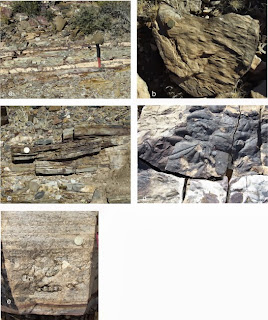Interesting Environmental Changes Documented in Namibian Ediacaran NeoProterozoic

Stratigraphy, Palaeontology and Geochemistry of the late Neoproterozoic Aar Member, southwest Namibia; Reflecting environmental controls on Ediacara fossil preservation during the terminal Proterozoic in African Gondwana
Authors:
Hall et al
Abstract:
Common, Ediacaran fossils are well preserved in a Late Neoproterozoic (ca. 545 Ma) shallow marine sequence, described here as the Aar Member of the Dabis Formation (Kuibis Subgroup, Nama Group), near Aus in southwest Namibia. This 31-38 m thick, shale-dominant unit records the transition from fluvial-shallow marine Kliphoek Sandstone to open marine limestone of the Mooifontein Member of the Zaris Formation, deposited on a subsiding continental margin during a major, regional transgression. Thin sandstone beds contain fossils at a number of levels throughout the Aar Member. Concentrations of Pteridinium were mostly transported in flood-derived sheets, while some Ernietta assemblages are preserved close to in-situ. Rangea has also been transported, and is mostly confined to thin sandstone lenses incised into mudstone. Limestone beds, common throughout, include at least two marker horizons that can be followed regionally and show local evidence of storm reworking. Systematic sampling and analyses of limestone reveals enrichment in both 13C and 18O higher in the section, with negative δ13C near the base rising to moderate positive values near the top. The negative-to-positive transition in δ13C values is more pronounced in the east, with all of the lower Aar Member samples consistently depleted in 13C. While this may reflect greater degrees of alteration by meteoric or dewatering fluids, the same carbonates are notably enriched in 18O relative to those at the same stratigraphic position to the west. The overall rise in 13C is attributed to greater proportional burial of organic matter and release of oxygen to surface environments, while the spatial variability is likely the result of a strong surface-to-deep carbon isotopic gradient in seawater. A number of the fossils, especially Rangea, are encrusted with jarosite, an iron-bearing sulphate mineral and common weathering product of pyrite. This observation suggests that preservation of the fossils may have resulted from the rapid encrustation of pyritic on the surface of the organisms as they decomposed and were consumed by sulphate-reducing bacteria within the sandy, near shore sediments. Insofar as pyrite formation requires iron, which is soluble and reactive in anoxic solutions, it is likely that the deeper subtidal environments lacked oxygen. In-situ pyritized forms like Ernietta may have developed the capacity to survive under episodically anoxic or sub-oxic environmental conditions, while Pteridinium and Rangea lived within an oxygenated estuarine or fluvial setting and were transported during storms to anoxic, ferruginous environments where they were exquisitely preserved

No comments:
Post a Comment